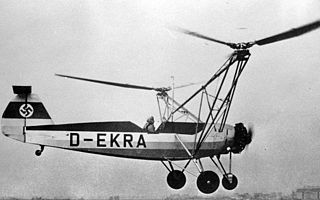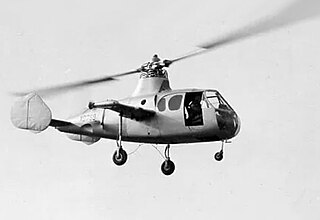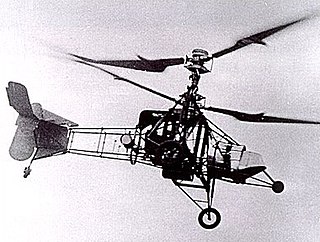
The Focke-Wulf Fw 61 is often considered the first practical, functional helicopter, first flown in 1936. It was also known as the Fa 61, as Focke began a new company—Focke-Achgelis—in 1937.

Alexander Lippisch's Delta IV was a continuation of his work on delta wing designs pioneered in his Delta I, Delta II and Delta III aircraft.

The tail rotor is a smaller rotor mounted vertically or near-vertically at the tail of a traditional single-rotor helicopter, where it rotates to generate a propeller-like horizontal thrust in the same direction as the main rotor's rotation. The tail rotor's position and distance from the helicopter's center of mass allow it to develop enough thrust leverage to counter the reactional torque exerted on the fuselage by the spinning of the main rotor. Without the tail rotor or other anti-torque mechanisms, the helicopter would be constantly spinning in the opposite direction of the main rotor when flying.
The Flettner 184 was a German night reconnaissance and anti-submarine autogyro developed during the 1930s.

The Flettner Fl 282 Kolibri ("Hummingbird") is a single-seat intermeshing rotor helicopter, or synchropter, produced by Anton Flettner of Germany. According to Yves Le Bec, the Flettner Fl 282 was the world's first series production helicopter.

A rotorcraft or rotary-wing aircraft is a heavier-than-air aircraft with rotary wings or rotor blades, which generate lift by rotating around a vertical mast. Several rotor blades mounted on a single mast are referred to as a rotor. The International Civil Aviation Organization (ICAO) defines a rotorcraft as "supported in flight by the reactions of the air on one or more rotors".

The Fairey Jet Gyrodyne is a British experimental compound gyroplane built by the Fairey Aviation Company that incorporated helicopter, gyrodyne and autogyro characteristics. The Jet Gyrodyne was the subject of a Ministry of Supply (MoS) research contract to gather data for the follow-up design, the Rotodyne.

A helicopter is a type of rotorcraft in which lift and thrust are supplied by horizontally spinning rotors. This allows the helicopter to take off and land vertically, to hover, and to fly forward, backward and laterally. These attributes allow helicopters to be used in congested or isolated areas where fixed-wing aircraft and many forms of short take-off and landing (STOL) or short take-off and vertical landing (STOVL) aircraft cannot perform without a runway.

The Henschel Hs 124 was a twin-engine heavy fighter, attack aircraft and light bomber designed in Nazi Germany. After two prototypes had been built, work on the project was cancelled.

The Heinkel He 72 Kadett ("Cadet") was a German single-engine biplane trainer of the 1930s.

The Gyroplane Laboratoire was an early helicopter. Its designer, Frenchman Louis Bréguet, had already experimented with rotorcraft in 1909; however, he chose to concentrate on airplanes until the end of the 1920s. In 1929 he announced a set of patents which addressed the flight stabilization of rotorcraft, and, in 1931, Bréguet created the Syndicat d'Etudes de Gyroplane, together with Rene Dorand as technical director. Their goal was the development of an experimental helicopter, the Gyroplane Laboratoire.

The Fairey FB-1 Gyrodyne is an experimental British rotorcraft that used single lifting rotor and a tractor propeller mounted on the tip of the starboard stub wing to provide both propulsion and anti-torque reaction.

The Flettner Fl 265 was an experimental helicopter designed by Anton Flettner.

The Doblhoff/WNF 342 was an early experimental tip jet helicopter designed and produced by Wiener-Neustädter Flugzeugwerke. It was the first helicopter to take off and land using tip jets to drive the rotor.
The Flettner Gigant was an experimental helicopter built in Germany during the early 1930s.

The Pescara Model 3 was the first of several coaxial helicopter designs by Raúl Pateras Pescara to demonstrate sustained controlled helicopter flight.
A rotor wing is a lifting rotor or wing which spins to provide aerodynamic lift. In general, a rotor may spin about an axis which is aligned substantially either vertically or side-to-side (spanwise). All three classes have been studied for use as lifting rotors and several variations have been flown on full-size aircraft, although only the vertical-axis rotary wing has become widespread on rotorcraft such as the helicopter.

The SNCAC NC.2001 Abeille was a single engine, twin intermeshing rotor helicopter designed and built in France in the late 1940s. Three were completed but only one flew, development ending when SNCAC was closed.
The Nord 1700 Norélic or SNCAN N.1700 Norélic was a French helicopter with several novel control features. Only one prototype was built, though it was intended to lead to series production.
The Gotha Go 241 was a low-wing twin-engined four-seat transport aircraft manufactured by Gothaer Waggonfabrik in the early 1940s and intended for the general aviation market.















